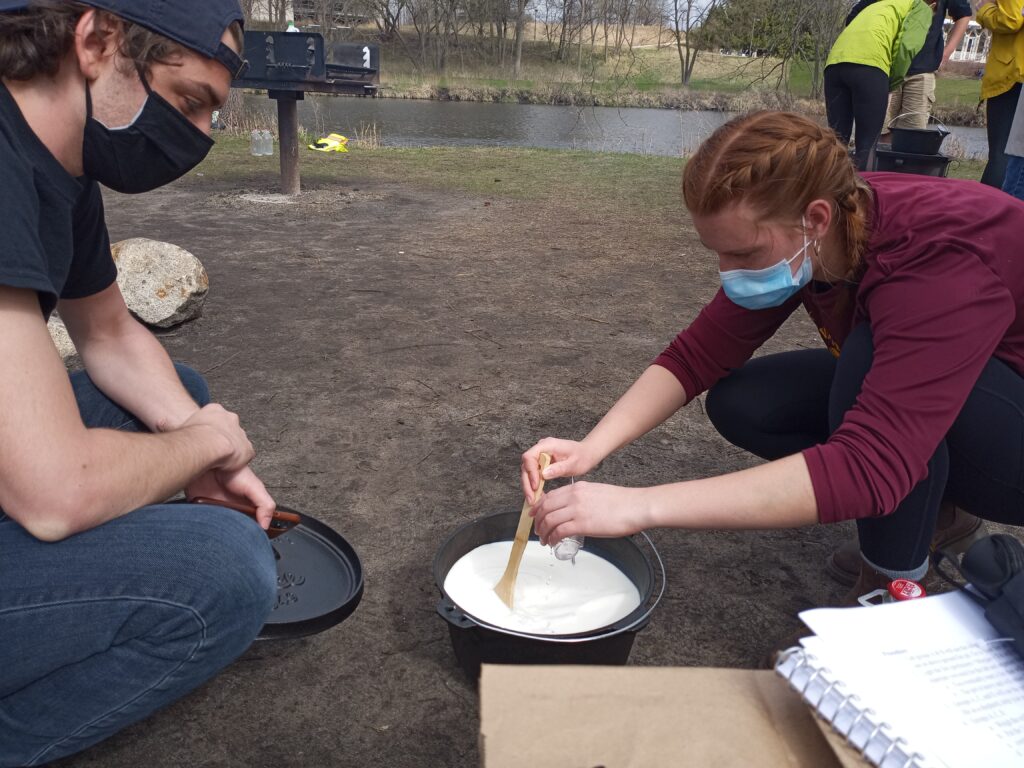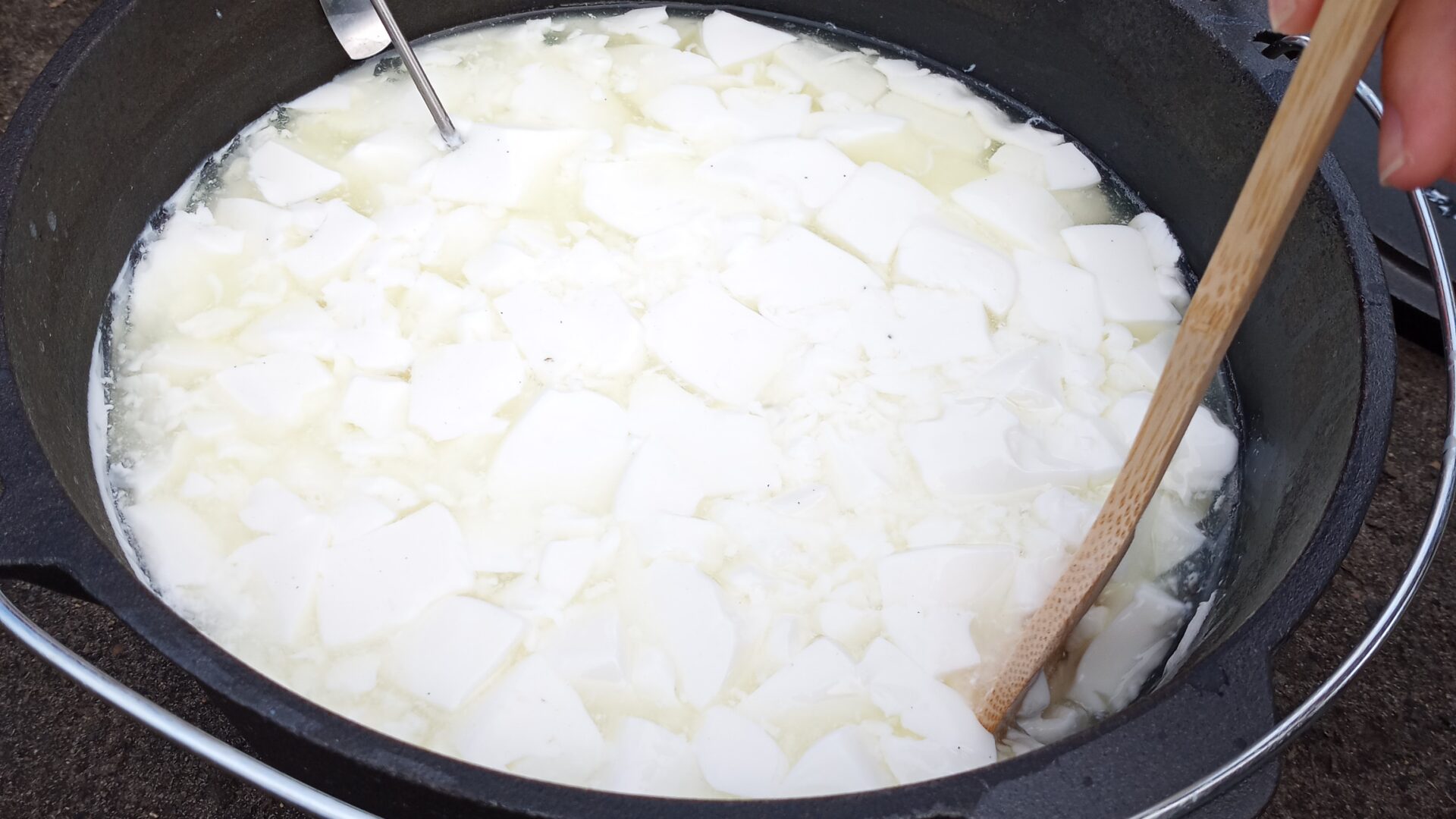Group B: Trina, Sam, Andrew, and Raine (recorder)
Thursday, April 8th, 2021 on Mai Fete Island
Weather: 63°F, windy, partly cloudy
Used the open fire throughout

Initial Measurements
| Pot Temperature | 79°F (important to note because we went second, so the pot had been heated already) |
| Milk Temperature | 69.1°F |
| Milk Volume | 1 Gallon |
| Milk Weight | 3.877 kg |
| Water Volume | 2 cups |
| Water Weight | 0.430 kg |
| Vinegar Volume | 1/4 cup |
| Vinegar Weight | 0.054 kg |
| Total (Milk+Water+Vinegar) Weight | 4.361 kg |
Pre-Rennet Timeline
Here, we slowly combined the vinegar-water mixture with the milk and then set the pot over the fire to heat it to 90° F.
| Time | Time Since Beginning (minutes) | Temperature (°F) | Actions/Observations |
| 3:09 | 0 | Poured vinegar into milk slowly while stirring | |
| 3:10 | 1 | 68° | Placed pot on fire |
| 3:14 | 5 | Tent fell over, we had to restart our rennet solution | |
| 3:15 | 6 | 75° | |
| 3:16 | 7 | 80° | Added another log |
| 3:18 | 9 | 82° | Still looks like milk, has some specks of ash in it |
| 3:20 | 11 | 86° | |
| 3:22 | 13 | 89°-90° | Took pot off fire, added in the dissolved rennet tablet and water. Placed the lid on the pot to retain heat. |

Post-Rennet Timeline
Here, we added in the rennet and waited for the curds to form while trying to maintain 90°F.
| Time | Time since adding Rennet (minutes) | Temperature (°F) | Actions/Observations |
| 3:22 | 0 | 90° | Added rennet, placed lid on pot to retain heat |
| 3:26 | 4 | 88° | Took the lid off, placed pot near fire to keep warm |
| 3:34 | 12 | 89° | |
| 3:37 | 15 | 87° | Added half of a log to the fire |
| 3:42 | 20 | 105°/85° | Took pot off the fire entirely. Because we placed the log barely under the pot, one side of the milk got heated much more than the other side |
| 3:45 | 23 | Achieved clean break; Cut the curd into rough cubes; stirred the pot | |
| 3:48 | 25 | 92° | Stirred the pot |
| 3:52 | 29 | 90° | Stirred the pot again; Curd texture: very very loosely formed, soft, almost falls apart on touch |
| 3:58 | 35 | 90° | Stirred the pot; starting to look more solid |
| 4:04 | 41 | 90° | Curd texture: feels soft, breaks apart slightly less than earlier, more separated on the surface |

Straining timeline
Because we were the second group to go, we had less time to strain our curds and whey, and we did not get a chance to make actual cheese out of them.
| Time | Time since pouring into strainer (minutes) | Actions/Observations |
| 4:09 | 0 | Curds and whey poured into strainer with cheesecloth. |
| 4:18 | 9 | Curds are soft to touch, still quite wet |
| 4:33 | 24 | Curds and whey taken to be measured |
Final Measurements
Consider that these measurements were only made after 24 minutes of straining, so the curds and whey may not have been fully separated.
| Weight of Curds | 1.710 kg |
| Volume of Whey | about .75 gal |
| Weight of Whey | 2.597 kg |
Miscellaneous Qualitative Observations (from other groups)
From the Mozzarella Group: the curds were falling apart a little bit in the water, breaking into pieces that almost looked like styrofoam. The water was at 150°F. The final product tasted salty and milkier than store-bought mozzarella usually tastes, but overall good.
From the Whey Cheese Group: The only-whey group produced negligible cheese–it tasted a little salty and maybe a little smoky, but you had to get that cheese by literally scraping the cheesecloth. The 25% curd whey cheese tasted faintly like milk and was soft and a bit chewy.


0 thoughts on “Lab 2: Cheesemaking Data”